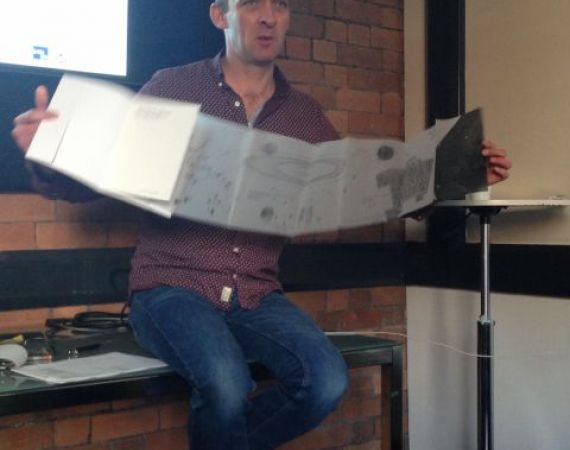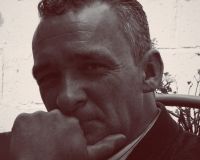Lunchtime talk write-up
Posted on Fri 29 Jan 2016
Ambient Literature with Tom Abba
“What the dickens is ambient literature?”

Speaker

Tom Abba
Tom Abba is a writer and designer working with the form of digital and physical books. He is an Associate Professor of Art & Design at UWE, a Director of Circumstance, and teaches into Drawing and Print at Arnolfini.“What the dickens is ambient literature?”
Tom Abba is at the start of a two-year AHRC funded research and practice project exploring and marking out the parameters of ambient literature, a term coined in 2013. Ambient Literature is defined as “a literary experience responsive to a reader’s situation, delivered or mediated by digital technology”
Tom described how his interest in the relationship between space, location, narrative, technology and storytelling arose during an Art Foundation degree assignment to create 100 drawings of place over one wet and windy weekend and stayed with him in the 20 years since.
Tom spoke about the markers of territory the team will be working within and around during this project:
Space – how can the space you are in shape and alter the story you are reading/hearing/presented with? When the writer knows where the reader is standing, what they can see, hear and smell, then the writing can allow for and influence the reader’s sense of presence in the space.
Architecture – there will be many questions around how you make work that locates itself within a specific architecture. How it responds to and works with that architecture, for example by exploring the traces of data that live and grow within a building. There is also a broader question to be addressed around the differences between urban and rural architecture.
Maps – this refers not necessarily to a plan of city streets, or a set of directions, but more broadly to each individual’s learnt map of a place. A personal map can incorporate a set of sights, smells, and sounds. These locative memories can be retriggered when a specific space is re-entered. Tom thinks exploring (and exploiting) personal maps is key to the development and creation of ambient literature.
Distraction – an urban environment provides a myriad of distractions, which shift temporally, seasonally, annually and daily. Any piece of locative literature needs to work with these changing distractions and not against them. Writing for a continually evolving environment throws up many challenges.
Sound – this is simplest form of immersion, and one that Tom has considerable experience in through his work as Director of Circumstance, who design narrative driven experiences in public space. Sound can direct your attention and ground you in a state of presence. It has the capability to be completely located, and responsive to your movements.
Writing – this project is starting with no preconceived ideas about genre. Tom is interested in the relationship between the content and the form. Each piece will be using technology (in some way), and the writing and development process will be iterative.
Over the next two years, this project will begin to design and develop the field of ambient literature through mapping out the existing canon of work, and allowing the academic research to influence three new commissioned works and vice versa. There will be a strong relationship to industry through the Advisory Team, which includes the UK’s two largest trade publishers. Tom and Jon Dovey will be podcasting during the project, and there will be regular seminars.